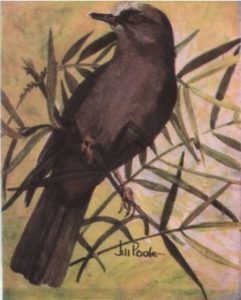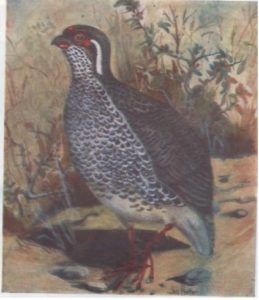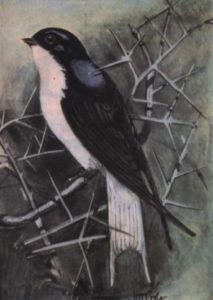Endemic Birds of Ethiopia
Of the 835 species of birds known to occur in Ethiopia, 23 are found exclusively within the country’s boundaries. Most of these 23 endemic birds are widely distributed, chiefly on the western and southern highland plateau. Many of the endemic birds of Ethiopia- like Thick-Billed Raven, Wattled Ibis, Black Winged Love bird and White Collared Pigeon- are notably common over extensive areas of the plateau, and, because they are big readily identified and not especially shy, they are consequently easy to see and observe. Even in the highland forests which support comparatively few endemic species of birds, the endemics are nevertheless obvious and common. The song of one- the Abyssinian Cat bird – is considered to be one of the most beautiful of any bird in Africa, Three Ethiopian Endemics are confined to the southern edge of Ethiopian plateau: they are the stresemann’s Bush-Crow, The white Tailed Swallow and Prince Ruspoli’s Turaco. Another endemic Ethiopian bird, The Blue- Winged Goose, is a very isolated species: its closest relative is a Goose which occurs in South America.
It is surprising that the biology of obvious and common endemic birds of Ethiopia remains poorly known, For the Scientist, they provide a great number of interesting problems of investigation: for the tourist, they provide a very enjoyable opportunity of seeing something new and unique: for the bird watcher, they provide the experience of observing 23 birds found nowhere else in the world.
Abyssinian Catbird
(parophasna galinieri) Wing 83 – 91 mm
 The Abyssinian Catbird – one of the finest, if not the finest singer of all the birds of Africa – is frequent to common in the western and southern highland between 1800 and 3500 meters in giant heath, St. John’s wort, highland bamboo, juniper, podocarpus and olive forests. It lives singly, in pairs or in parties up to eight often in thickets and vines that fringe these forests. It is found as far north as the Semen Mountains; the catbird is a resident garden bird of plateau cities.
The Abyssinian Catbird – one of the finest, if not the finest singer of all the birds of Africa – is frequent to common in the western and southern highland between 1800 and 3500 meters in giant heath, St. John’s wort, highland bamboo, juniper, podocarpus and olive forests. It lives singly, in pairs or in parties up to eight often in thickets and vines that fringe these forests. It is found as far north as the Semen Mountains; the catbird is a resident garden bird of plateau cities.
One usually first notices the catbird when it sings. The birds, which appear to be territorial, are intense singers in the rains when a male and a female often duet persistently. The male, stretching his neck skyward and holding his wings out at the bend, vigorously produces a long clear ringing song; the female answers with a churring and purring note. Because the little – known catbird lives in dense parts thickets, it is sometimes difficult to see. Distinguishing features are its general grayish, color, dirty white forehead and chestnut belly and undertail coverts.
This endemic in known to feed own juniper berries, but other items in its diet are not known. It certainly nests in May and July; it probably nests from February through July. The nest is a small, frail, thin, cup-like structure of plant stems placed loosely in tangle of vines; one was discovered 5 meters up in a St. Jhon’s Wort tree. The eggs, two in number, are pale flesh – colored and uniformly covered with fine flesh marks and a few dark chestnut spots.
Wattled Ibis (Bostrychia carunculata)
Wing 325 – 380 mm
 Because of its loud, raucous call, the wattled Ibis is clearly recognized even from some distance away. The Wattled Ibis occurs throughout the Ethiopian plateau from about 1500 meter to the highest moorland, it is most common highland river courses with rocky, cliff-like edges but it is found also in open country and in olive, juniper, podocarpus, hagenia, St. John Wort and giant heath forest and occasionally in Eucalyptus stands. The Ibis is gregarious, often flocking in groups of 50 to 100, rarely it is found alone. Small folks of Ibis can be seen in Addis Ababa. The birds normally roost on cliff edges.
Because of its loud, raucous call, the wattled Ibis is clearly recognized even from some distance away. The Wattled Ibis occurs throughout the Ethiopian plateau from about 1500 meter to the highest moorland, it is most common highland river courses with rocky, cliff-like edges but it is found also in open country and in olive, juniper, podocarpus, hagenia, St. John Wort and giant heath forest and occasionally in Eucalyptus stands. The Ibis is gregarious, often flocking in groups of 50 to 100, rarely it is found alone. Small folks of Ibis can be seen in Addis Ababa. The birds normally roost on cliff edges.
Little known about the Ibis’s breeding habits. The pre-nuptial behavior including the establishment of pairs and preparation of nesting sites as well as length of incubation and brooding behavior are not known.
Harwood’s Francolin (Francolinus Harwood)
Wing 180 – 190 mm
 Harwood’s Francolin has been reported from only three localities along about 160 Km. valleys and gorges with in the upper Blue Nile system extending to the east and north of Addis Ababa – Debre Markos. This Francolin is a very poorly known Ethiopian endemic. It was first recorded in 1898 at Ahiyafej (10° 13”N, 39° 18”E) and again in 1927 at Bichena (10 26’N, 38 13’E) and in 1930 at Kalo Ford along the banks of the Blue Nile “below Zemie” (10° 09’N, 38° 22’E). No other records of this species have been published although recent reports suggest that it is more widely distributed than previously thought.
Harwood’s Francolin has been reported from only three localities along about 160 Km. valleys and gorges with in the upper Blue Nile system extending to the east and north of Addis Ababa – Debre Markos. This Francolin is a very poorly known Ethiopian endemic. It was first recorded in 1898 at Ahiyafej (10° 13”N, 39° 18”E) and again in 1927 at Bichena (10 26’N, 38 13’E) and in 1930 at Kalo Ford along the banks of the Blue Nile “below Zemie” (10° 09’N, 38° 22’E). No other records of this species have been published although recent reports suggest that it is more widely distributed than previously thought.
Very little can be said about the biology of this Francolin. The male can be recognized by a distinctive U-shaped pattern on the black and white feathers of the breast, the female is unknown to science. Its referred surroundings are unknown, its egg, nest, time of nesting, food, call and general behavior are not described. Since the local people at least in the late 1920’s and 1930’s were familiar with the Harwood’s Francolin, it seems reasonable to assume that it may have been more common than thought at that time and may still be so today. Two species very closely related to the Harwood’s Francolin occur in central and southern Africa. The two, the Hildebrandt’s Francolin (Francolinus hildebrandti) and the Natal Francolin (F. natalensis) are specially found in dense bush along stream beds and rocky hills covered with long grass or bush. It again seems very reasonable to assume that the Harwood’s Francolin lives in similar habitat in the Blue Nile Valley system.
Prince Ruspoli’s Turaco
(Turaco ruspollii) Wing 180 – 184 mm
 Prince Ruspoli’s Turaco is known in the literature from two areas in southern Ethiopia in juniper forests with dense evergreen undergrowth, one is at Arero (4° 48’N, 38° 50’E) and the other 80 km north of Negelle (5° 50’N, 39° 20’E) both localities are 1800 meters in elevation. This Turaco was first introduced to science when prince Ruspoli collected it in either 1892 or 1893. Since prince Ruspoli an Italian explorer was killed in an “encounter with an Elephant” in the lake Abaya area and unfortunately did not leave any notes about his travels, the locality and date of collection of the first specimen of this Turaco remain unknown. His collection was studied by T. Savadori in 1896 who named the new Turaco in honor of Prince Ruspoli. In subsequent years several other explorers searched for the Turaco; none was successful until the early 1940‘s when several specimens were obtained in the Arero forest. After these specimens were obtained the Turaco was not reported again until very recently, in the last five years, when several have been seen and for collected at the locality north of Negelle. This Turaco is considered to be an endangered species and is included in the “Red Book” of endangered animals of the world.
Prince Ruspoli’s Turaco is known in the literature from two areas in southern Ethiopia in juniper forests with dense evergreen undergrowth, one is at Arero (4° 48’N, 38° 50’E) and the other 80 km north of Negelle (5° 50’N, 39° 20’E) both localities are 1800 meters in elevation. This Turaco was first introduced to science when prince Ruspoli collected it in either 1892 or 1893. Since prince Ruspoli an Italian explorer was killed in an “encounter with an Elephant” in the lake Abaya area and unfortunately did not leave any notes about his travels, the locality and date of collection of the first specimen of this Turaco remain unknown. His collection was studied by T. Savadori in 1896 who named the new Turaco in honor of Prince Ruspoli. In subsequent years several other explorers searched for the Turaco; none was successful until the early 1940‘s when several specimens were obtained in the Arero forest. After these specimens were obtained the Turaco was not reported again until very recently, in the last five years, when several have been seen and for collected at the locality north of Negelle. This Turaco is considered to be an endangered species and is included in the “Red Book” of endangered animals of the world.
There are no breeding records nor any recorded observations on the nesting activities of Prince Ruspoli’s Turaco; its nets and eggs are unknown. It has been reported to feed on fruits of Teclea and Adina. Its call has been described as a low “chirr cha” and short “et”.
White – tailed Swallow
(Hirundo megaensis) Wing 100 – 105 mm
 The White – tailed Swallow was first introduced to science in 1942 when C.W. Benson reported it in southern Ethiopia from Yabelo to Mega in short grass savanna with small acacia thorn bush. This endemic related to the Pied – winged Swallow (Hirundo leucosoma) of western Africa and the pearl – breasted Swallow (H. dimidiata) of Southern Africa, is common but restricted to an area of about 4850 square kilometers between 1200 and 1350 meters. This restriction has baffled scientists because there is no obvious explanation, particularly no natural barrier or boundaries which mark off the area, for such a limited distribution. In recent years there have been reports of the Swallow in the Addis Ababa area. Studies of this species in the future may show that its distribution is not so limited as thought.
The White – tailed Swallow was first introduced to science in 1942 when C.W. Benson reported it in southern Ethiopia from Yabelo to Mega in short grass savanna with small acacia thorn bush. This endemic related to the Pied – winged Swallow (Hirundo leucosoma) of western Africa and the pearl – breasted Swallow (H. dimidiata) of Southern Africa, is common but restricted to an area of about 4850 square kilometers between 1200 and 1350 meters. This restriction has baffled scientists because there is no obvious explanation, particularly no natural barrier or boundaries which mark off the area, for such a limited distribution. In recent years there have been reports of the Swallow in the Addis Ababa area. Studies of this species in the future may show that its distribution is not so limited as thought.
The species is unique among swallows in having the greater part of the tail white; the white is very conspicuous in flight. The White – tailed Swallow is thought to be a sedentary species, remaining mainly in its home range. It is not associated with human habitation. C.W. Benson suggested that this swallow may build its nest in January and February in holes in the tall chimney – shaped ant hills common in the area; the nest however, has not been discovered.
Customized tours:
We welcome and encourage tailor-made tours to suit your needs (especially to those seeking specific bird species). You are many times in contact with our office, which is always happy to help you design a trip to suit your like.
